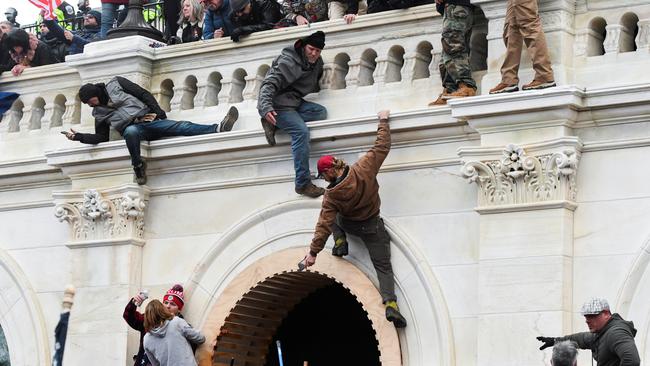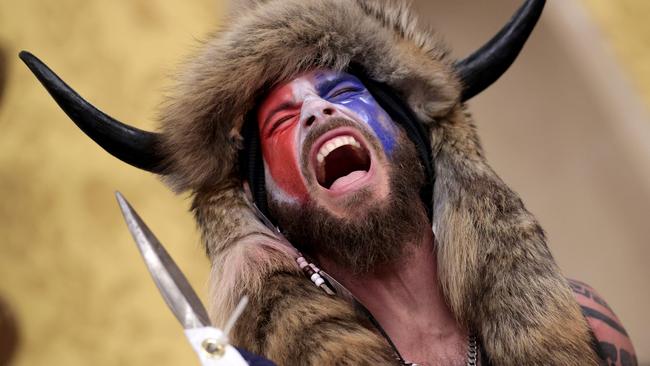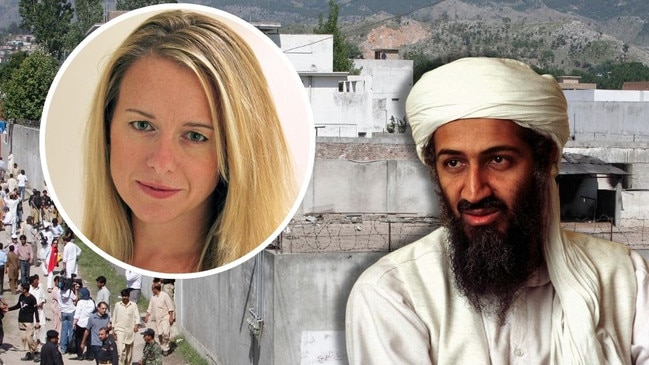For a journalist, no story comes close to this one
The Australian’s former US correspondent was outside the Capitol on the day an angry mob invaded, urged on by Donald Trump.

I was walking to the White House to listen to Donald Trump speak to his angry supporters about the “stolen” election when I spotted him. He was standing in the middle of the road, wearing a fur headdress with bison horns and holding a spear with an American flag on it. He was shirtless and his face was painted in red, white and blue. The man, who the world would soon know as Jacob Chansley, or the “QAnon Shaman”, was yelling into a loudspeaker, saying, “This is our 1776, baby”, referring to the year of America’s Independence.
I stood and watched him for some time, even taking a short video and a photograph. It was January 6, 2021, and the mood in America was dark. Trump had spent the past two months claiming he had won the November 2020 presidential election and that his rival, Joe Biden, had lost. Biden was to be inaugurated as president in two weeks and Trump was in a rage.

As I walked to the White House that day, I could sense the anger in the air. I had attended many Trump rallies across America during my four years as The Australian’s Washington correspondent but never one as ominous as this. The Trump supporters who had flown into Washington on January 6 were not the usual Trump-rally crowd. Those people were mostly local farmers or small-town families who were noisy and passionate during the rally, but once it was over, they reverted to their polite selves, happy to shake your hand, chat and even invite you for a beer.
The crowd I saw in Washington on January 6 was a very different mob. These were hardliners, including groups such as the far-right Proud Boys and others who clearly did not fly all the way to Washington to simply attend a rally.
For Trump it was easy to egg them on, and I watched as the President, speaking from behind bullet-proof glass, urged the tens of thousands of protesters to march on Congress to “stop the steal’’. As I was listening to Trump and scribbling down notes, I remember being shocked at how incendiary his words were. You could feel their impact on those around me as he goaded them to do something, anything, to demonstrate their rage.

Afterwards, as I walked with the mob to the Capitol building, where they gathered in a large group, chanting slogans and occasionally singing the national anthem, the atmosphere became ever more tense. Even so, I, along with most of the w––orld, could not believe what then unfolded. Some in the crowd crashed through the doors of the Capitol and into its hallowed -chambers. Others used ropes and makeshift ladders to climb the walls to get into the building. It was mayhem. I wondered where all the Capitol security guards had gone.
Images from cameras inside showed some protesters charging through the corridors, while others simply strolled around taking photos like tourists, as if they were surprised they had suddenly entered the beating heart of American democracy.

It was then that I saw him again, this time on the television. Jacob Chansley, the horned QAnon Shaman who I had filmed in the street a few hours earlier, was standing in the US Senate, next to the chair usually occupied by then vice-president, Mike Pence. Chansley instantly became the face of the invasion of the US Capitol.
Australia was just waking up. I needed to write fast, to somehow describe to our readers this unprecedented moment in US history, referred to by former Washington police chief Charles Ramsey as being “as close to a coup attempt as this country has ever seen”.
I recall shaking my head in amazement as I typed. As a two-time US correspondent – in Washington during the Trump presidency and in New York in the late 1990s – I have witnessed some big moments.

Back in 1996, I had covered Bill Clinton’s second presidential campaign and stood outside the governor’s mansion in Little Rock, Arkansas, on election night as the re-elected president gave his victory speech alongside his wife Hillary and young daughter Chelsea.
Twenty years later, on election night 2016, having covered the Trump–Hillary Clinton campaign, I attended Hillary’s election party in New York City where the upbeat atmosphere became funereal when Trump pulled off his come-from-behind win.
Along the way, I covered American wars, scandals and mass shootings while having the privilege to interview vice-president Dick Cheney, Republican presidential candidate John McCain, Microsoft founder Bill Gates and even Hollywood A-listers Julia Roberts, Cameron Diaz and Meryl Streep.
But none of these stories came close to what unfolded on January 6. It was a story no journalist could have imagined because it was so unthinkable that an angry crowd of Americans might storm the cradle of their own government to demand that a democratic election be overturned.
To be an eyewitness to the Capitol riot in Washington on January 6, 2021, felt like covering much more than just a story. It felt like sitting in the front row of history.

As it happened
Cameron Stewart watched proceedings unfold in Washington as democracy prevailed over one of the most astonishing insurrections in history, published January 8, 2021.

Joe Biden has been certified as US president in an early morning sitting of congress forced by a violent assault on the US Capitol by Donald Trump supporters that left four people dead and Washington DC in a state of emergency.
On a day that sparked condemnation from all sides of US politics, mobs of Trump supporters crashed the doors of the Capitol Building, bringing the beating heart of America’s democracy to an abrupt halt.
The protesters were incited to march upon the Capitol by the outgoing President who told tens of thousands of supporters that “we will never give up and never concede, we will stop the steal”.
“If you don’t fight like hell, you’re not going to have a country anymore,” he said.
Congress resumed its session to formally endorse the Electoral College vote to ratify Mr Biden’s victory, hours after the protesters were evicted, but a state of emergency, including a 6pm-6am curfew, will remain in force in Washington until Mr Biden’s inauguration on January 20.
Ashli Babbit, a military veteran who had travelled from California, died in hospital after being shot inside the Capitol. Three other protesters died of medical issues.
Police reported 52 arrests including 26 on US Capitol grounds.
Mr Trump, in a statement released after the congressional vote ratifying Mr Biden, promised an orderly transition of power.
“Even though I totally disagree with the outcome of the election, and the facts bear me out, nevertheless there will be an orderly transition on January 20th,” he said.
“I have always said we would continue our fight to ensure that only legal votes were counted. While this represents the end of the greatest first term in presidential history, it’s only the beginning of our fight to Make America Great Again.”
60th Anniversary Witnesses to history

For a journalist, no story comes close to this one
The Australian’s former US correspondent was outside the Capitol on the day an angry mob invaded, urged on by Donald Trump.

Simple instructions: ‘Wear a ballistic helmet and a bulletproof vest’
The kibbutzim might have been tiny villages but they were the model, in miniature, for how a future Israel could have looked next to its Palestinian neighbours. By all rights, our reporter shouldn’t have made it there. But he did.

A large Indigenous man on my porch had an unexpected message
The story of a marriage forbidden revealed systemic racism and led to a life-long connection. For our 60th birthday, Hugh Lunn recalls this touching story.

Inside story: How Osama bin Laden hid in plain sight
The Australian’s then-South Asian correspondent had numerous run-ins with armed Pakistani police while covering the story of the decade. But nothing they could dish out could have been worse than having to tell the editor she’d been kicked out.

Cold, furious: The most evil man I have ever met
Getting to interview this man was challenging. He hated ‘gringo’ journalists and had vowed he’d never talk to one again. All of my peers warned me he goes crazy if you ask him about the death squads. But I had to try.

‘Stop the presses’: breaking the news of new pope
When the wisps of white smoke billowed from the Vatican chimney, The Australian newspaper had long been put to bed. Our correspondent couldn’t wait another day to file. We share this story for our 60th anniversary.

The first big yarn to take a toll on Hedley Thomas
Being sent to cover the bloody overthrow of the communist regime in Romania was a seminal experience for a young reporter who would become one of The Australian’s most highly acclaimed journalists.

At the scene of the story that gripped the world
Reporting from the muddy mouth of the cave complex as a monsoon loomed, it felt crushingly inevitable we would be relaying grim news about a trapped junior soccer team. But then came a sudden turn.

